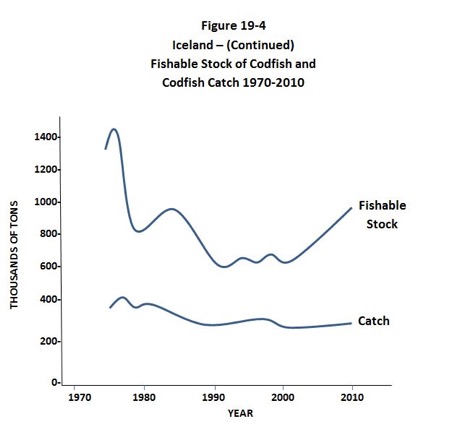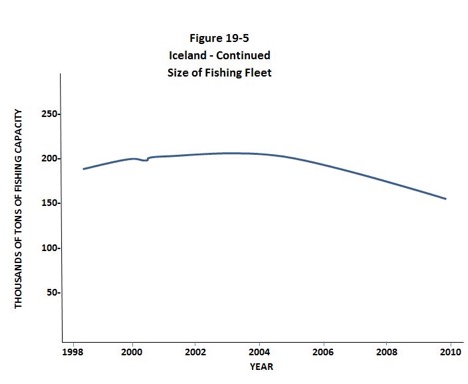| << Chapter < Page | Chapter >> Page > |

So, what was intended did occur: the total volume of the catch fell, the fishable stock increased, and fishing profits went up. The Iceland system has also achieved two other objectives – reducing the number of fishing vessels and reducing the overall capacity of the fishing fleet, as can be seen in Figure 19-5.

Consider the number of fishing vessels as the measure of capacity. This declined by 42% from 1992 to 2002. Although the size of the fishing fleet size did sharply decrease in terms of number of vessels, overall capacity declined only from 180 thousand tons in 1998 to 150 thousand tons in 2008. Why? Because the size of remaining boats became larger. So, the system also helped to increase efficiency in fishing fleet.
Important lessons have been learned from the ITQ systems in Iceland, New Zealand and Alaska. Successful operation of ITQs requires good institutions, good governance and ready accessible, affordable technology. Iceland holders of ITQs have to keep logbooks or board recordings each day's catch. They must all carry on board equipment that sends out electronic signals showing the location of the boat.
Effective enforcement is critical. Twice a year, each vessel is likely to go to sea with a government inspector on board, to observe fishing practice and handling of “by-catch.”
Clearly then, innovations such as ITQs can promote sustainable fishing. How large are the costs of unsustainable fishing ? A World Bank study in 2009 estimated the economic cost, arising from three sources:
These three factors added up to $2 trillion over the past 30 years “The Sunken Billions: The Economic Justification for Fisheries Reform,” Washington, DC: The World Bank , 2009, p.49. ($50 billion year). (This does not include economic losses due to recreational fishing). These are needless losses, because they could be avoided with appropriate reforms.
Just about anything that reduces the size of the world’s fishing fleet would aid sustainability of fish stocks.
Fishery stocks have been in decline everywhere, both in
salt water near the U.S. and Europe, and in waters off Africa, South Asia and Latin America. However, the combined result of ITQs on depletion of key fishing grounds and most recently commercial fish farms has stabilized the catch of wild fish at about 90 million tons per year. There has also been a decline in
fresh water fisheries. The obvious answer is overfishing (noted earlier). Another reason- environmental run-off has been poisoning the water killing fish as in waters such as the Gulf of Mexico as a result of the U.S. Ethanol subsidy (see previous chapter).
First look at issue
of overfishing . Why has there been too much
overfishing ?

Notification Switch
Would you like to follow the 'Economic development for the 21st century' conversation and receive update notifications?